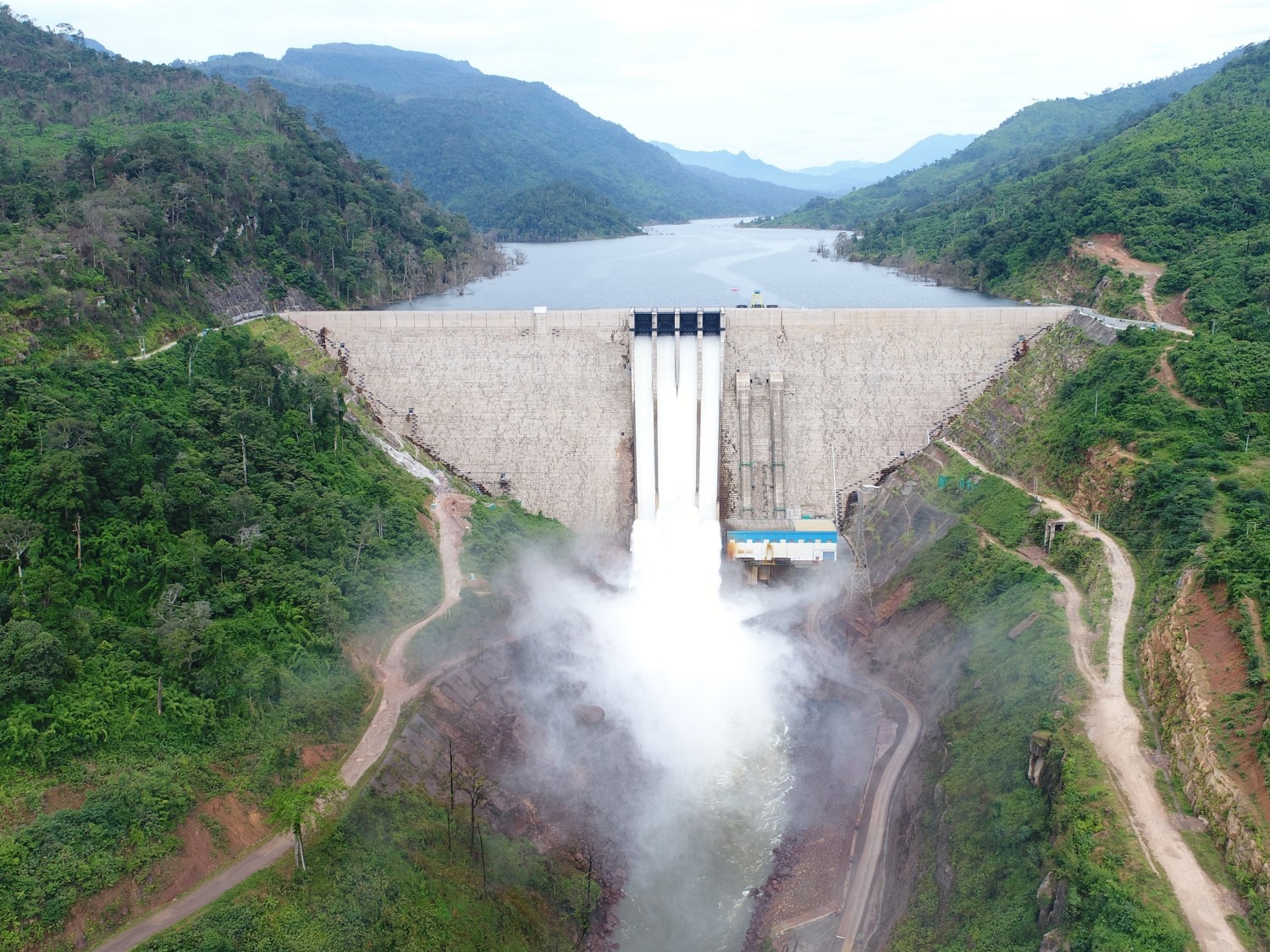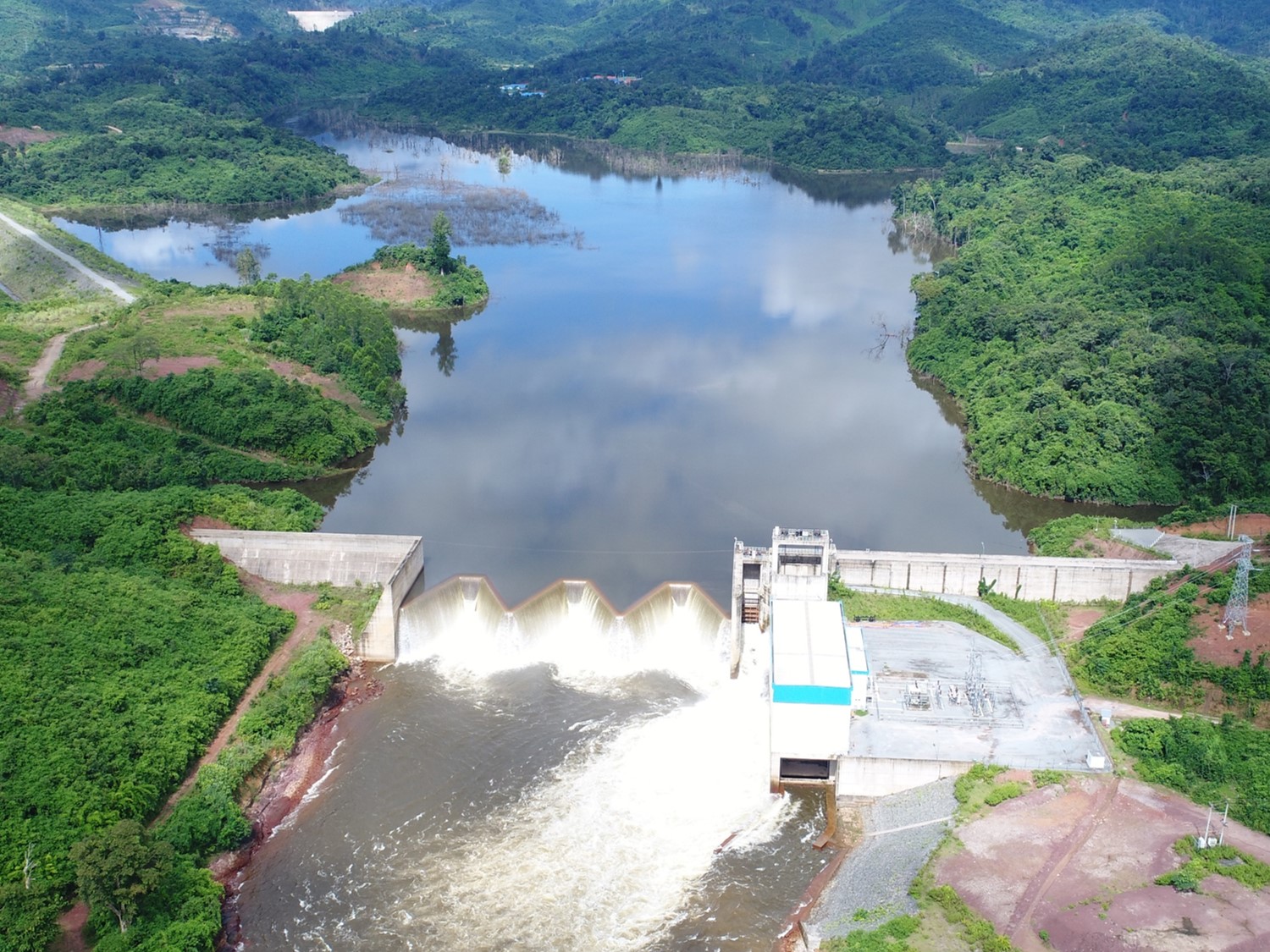1. PROJECT BACKGROUND.
Nam Ngiep 1 is a 290 MW hydropower project is located in Bolikhamxay and Xaysomboun provinces of the Lao PDR. The project is being built and
operated by the Nam Ngiep 1 Power Company, whose goal is to build a socially and environmentally responsible power project that provided clean renewable electricity and contribute to poverty reduction in Laos.
Two dams and power stations are constructed along the Ngiep River in Bolikhamxay. The main dam height 167 m willcreated a water storage reservoir covering a 67 km2 area extending into Xaysomboun province.
At the main dam site a primary power station generated around 272 MW of electricity for export to Thailand and release water to a regulating pond where a second dam and power station generate around 18 MW of electricity
for local use. The re-regulating dam ensures smooth release of water to minimize the disruption on water levels in the river downstream.
NNP1 together with local people and authorities build high-quality new houses and community facilities for the villagers moving to the Houaysoup area. The Company is also
developed a range of livelihood programmes for people affected by the project.
Environmental protection is also crucial to the long-term success of the project and NNP1 has created a dedicated Environmental Management Office to ensure that the project minimizes its local footprint and also contributes
to improved conservation measures and environmental awareness on a national scale.
2. Project Location.
The Project is located on the Nam Ngiep River, a tributary of the Mekong River. The river joins the Mekong at Pakxan which is located about 150 km away from Vientiane Capital. The Nam Ngiep River originates in Xiang Khouang Province and runs about 160 km before joining the Mekong, 1,300 m lower in elevation. The Project area stretch from Bolikhamxay Province to Xaysomboun Province, the main dam, re-regulation dam and powerhouse are located in Bolikhan District, Bolikhamxay Province while major part of the reservoir area belongs to Hom District, Xaysomboun Province.
3. Project History.
The Nam Ngiep 1 Hydropower Project was identified in the early 1990s and a preliminary feasibility study conducted in 1991. The Lao government’s agreements with the Project’s initial developers expired and in 1996 the government requested the Japan International Cooperation Agency (JICA) to conduct a full feasibility
study into social and environmental impacts and technical and commercial aspects.
The JICA study, conducted over two phases from 1998-2000 and from 2001-2002, confirmed the Project’s technical feasibility on a Build-Operate-Transfer basis and made recommendations for its optimal development
based on physical, economic and environmental and social safeguard considerations.
Japan’s Kansai Electric Power Company joined other interested Japanese partners on further studies in May 2003, and in April 2006 signed a project development agreement with the government. A year later Kansai and the Electricity Generating Authority of Thailand (EGAT) entered an agreement to develop the Project. The Consultations with people living in the project area continued alongside technical studies on topography and geology. On the legal development side, a revised Memorandum of Understanding on
tariffs was concluded in July 2011 and a Power Purchase Agreement signed in 2013.
In late 2013 and early 2014 preparations for construction began, with the planning of the access road. In May 2014 national-level consultations involving villagers, local officials, senior politicians, the project developers and financial backers, followed village, district and provincial level meetings. In September that year financial close was reached as the nine banks backing the project reached
agreement on fiscal and legal terms, paving the way for full construction to commence.
4. Shareholders.
The shareholder ratio is as follows



At the end of the concession period (in 2046) ownership of the Plant will be transferred entirely to the Lao state.
5. Project Design.
The Nam Ngiep 1 Project is designed to harness the energy potential of the lower part of the Ngiep River by creating a reservoir that will supply water to a power station situated below a 167 metre high dam.
The electricity generated at this facility will be exported to Thailand.
A second dam and small reservoir are to be built downstream of the main facilities in order to regulate water flows and so minimize disturbances to the river and people living further along the Nam Ngiep.
A smaller power station located at this Re-Regulating Dam will supply electricity for use in Laos.
Main Facilities
The Main Dam created the Reservoir, with a surface area of 70 square kilometers when at full supply level. The height and volume of the reservoir has been limited in order to reduce the number of people affected by the water level but it will still have an effective storage capacity of 1.,192 million cubic metres of water. The average depth of the reservoir will be about 74 m, ranging from a maximum of 167 m at the Main Dam, to just a few meters at the furthest point from the dam, approximately 70 km upstream.At the Main Dam, which is a Roller-Compacted Concreted gravity dam approximately 530 m in length, water from the reservoir dropped around 132 m to the Main Powerhouse, located on the left bank of the river when looking downstream. The Main Dam also features a spillway with four gates to enable extra release if the reservoir approaches full capacity. The ski-jump type spillway mitigates the effects of discharged water around the immediate downstream area and is designed to release up to 5.,200 cubic metres of water per second, enough to deal with a 1.,000-year maximum flood event.
The Main Powerhouse features two Francis Unit turbines that can together generate 272 MW of power, supplying 1.,546 GWh per year to the nearby substation.

Re-Regulating Facilities
Water discharged from the Main Powerhouse will flows into the Re-Regulating Reservoir, created so that a smooth discharge of water can be released on a daily basis downstream.By storing discharged water from the Main Dam during power peaks, re-using it for domestic power generation and releasing it downstream evenly on a 24-hour basis on weekdays, the re-regulation system helps to mitigate potential environmental impacts caused by fluctuations in water level.
The water can be released either directly through the Re-Regulation Dam, located 6,2 km downstream from the main dam, or through the Re-Regulation Powerhouse.
The Re-Regulation Dam is a free-overflow type concrete gravity dam approximately 90 meters long and 20 meters high.
The Re-Regulation Powerhouse with the installed capacity of 18 MW, generate 105 GWh of power annually through a single bulb type turbine. This power station will generate energy for delivery to EDL.

6.Specification.
| Nam Ngiep 1 Main Reservoir | |
|---|---|
| Reservoir surface area | 66.9 square kilometres at normal level |
| Effective storage capacity | 1.2 billion cubic metres |
| Catchment area | 3,700 square kilometres |
| Average annual inflow | 4.7 billion cubic meters or 148.4 m3/s |
| Nam Ngiep 1 Main Dam | |
| Type | Roller-Compacted Concrete Gravity Dam |
| Crest height | 167 meters |
| Crest length | 530 meters |
| Spillway Discharge Capacity (4 x radial gates) | 5,210 cubic meters per second |
| Penstock Tunnel Length | 185 meters |
| Penstock Tunnel Diameter | 5.2 meters |
| Nam Ngiep 1 Main Powerhouse | |
| Turbine and generator | 2 Francis Units |
| Effective head | 130.9 meters |
| Rated output | 272 MWs |
| Annual power generation | 1,546 gigawatt hours |
| Transmission line | 230 kilovolt line, 125 km to Nabong Substation |
| Nam Ngiep 1 Re-Regulation Reservoir | |
| Reservoir surface area | 1.27 square kilometres at normal level |
| Effective storage capacity | 4,600,000 cubic meters |
| Catchment area | 3,725 square kilometers |
| Nam Ngiep 1 Re-Regulation Dam | |
| Type | Concrete Gravity Dam |
| Crest height | 20 meters |
| Crest length | 90 meters |
| Discharge Capacity (fixed wheel gate) | 5,210 cubic meters per second |
| Nam Ngiep 1 Re-Regulation Powerhouse | |
| Turbine and generator | 1 Bulb Unit |
| Effective head | 12.7 meters |
| Rated output | 18 MWs |
| Annual power generation | 105 gigawatt hours |
| Transmission line | 115 kilovolt line, 40 km to Pakxan Substation |
7.Power sales.
The energy generated by the Nam Ngiep Hydropower Plant is sold to the national electricity utilities of Laos and Thailand. In August 2013 NNP1 signed Power Purchase Agreements with both the Electricity Generating Authority of Thailand (EGAT) and Electricité du Laos (EDL). The agreements set out the basic terms and conditions for electricity sales from the project, including unit price, basic operation patterns and the duration of the sales period. The Nam Ngiep 1 Main Powerhouse, which can generate around 1.,546 GWh per year, all export to Thailand through a 230 kV transmission line to Nabong sub-station in Vientiane, from where it conveyed across the Mekong River to Thailand through a 500 kV line. The Nam Ngiep 1 Re-Regulating Powerhouse sells about 105 GWh per year to EDL through a 115 kV transmission line that runs to the Pakxan sub-station in Bolikhamxay. NNP1 is operated under the 27 years concession agreement. During this period the Nam Ngiep Hydropower Project expects to contribute more than US$ 600 million to Lao PDR through royalty fees, taxes, and dividends paid to the Laos Holding State Enterprise, the Government shareholder in the Project. Lao PDR not only expects to benefit directly from the Project through electricity supply, but also indirectly through local employment, community infrastructures such as roads and bridges, and through the use of goods and services supplied to the Project by Lao businesses. Nam Ngiep 1 Power Company is committed to helping the Lao Government to alleviate poverty and bringing prosperity to people in Lao PDR.Electricity sales to EGAT and EDL
Production And Revenue Data
| Period | EGAT(GWh) | EDL(GWh) | Total(GWh) |
|---|---|---|---|
| Plan 2022 | 1,653.40 | 200.05 | 1,853.45 |
| Percentage(%) | 82.23% | 68.03% | 72.67% |
| 01/2022 | 148.64 | 22.09 | 170.69 |
| 02/2022 | 135.68 | 19.93 | 155.61 |
| 03/2022 | 1,020.16 | 63.05 | 1,083.21 |
| QuarterI | 2,523.80 | 135.97 | 2,659.77 |
| 04/2022 | 961.98 | 61.36 | 1,023.35 |
| 05/2022 | 1,018.67 | 48.99 | 1,067.66 |
| 06/2022 | 1,099.33 | 26.02 | 1,067.66 |
| QuarterII | 3,080 | 136 | 3,216 |
| 07/2022 | 1,095.37 | 27.35 | 1,122.72 |
| 08/2022 | 1,099.83 | 26.02 | 1,125.85 |
| 09/2022 | 1,126.09 | 29.20 | 1,155.29 |
| QuarterIII | 3,321 | 83 | 3,404 |
| TOTAL2022 | 73,918 | 3,199 | 77,116 |

